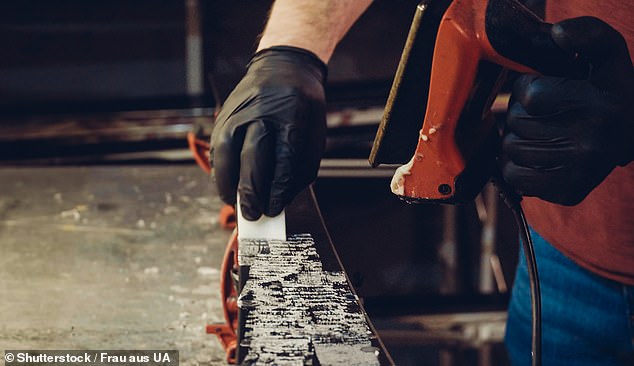Skiers leave chemicals ‘forever’ on the slopes: Scientists discover dangerously high levels of 14 PFAS spread across Austrian ski resorts
Skiers chasing smoother slopes are leaving a trail of toxic ‘forever chemicals’ in their wake, a new study has found.
Scientists have found high levels of PFAS chemicals commonly used in ski wax in the snow and soil of Austrian resorts.
Although wax containing PFAS reduces friction between snow and skis, experts from the James Hutton Institute in Aberdeen and the University of Graz in Austria warn it can also pose a dangerous hazard.
These chemicals have been linked to cancer, thyroid disease, fertility problems and liver damage.
Viktoria Müller of the James Hutton Institute says: ‘These chemicals are called forever chemicals because they take hundreds of years to break down.’
Scientists say skiers looking for a smoother ride may be leaving a trail of toxic ‘forever chemicals’ behind from the wax used on their skis (stock image)
The researchers collected snow and soil samples from family ski sites in the Austrian Alps, as well as six commercially available ski washes.
These samples were then tested for 30 of the most common per- and polyfluoroalkyl substances, also called PFAS, found in ski wax.
Testing showed that 14 different types of PFAS were found at much higher levels than in areas not normally used for skiing.
Similarly, five out of six ski waxes tested contained high levels of PFAS, despite these compounds being recently banned from professional skiing events.
Ms Müller said: ‘While there have been concerns about the use of PFAS in ski wax for some time, this study on alpine ski slopes has shown that skiing will produce orders of magnitude higher concentrations of PFAS in any skiing area where this type of skiing activity takes place. wax is used.’
The more concerning discovery, however, was that there were higher-than-normal concentrations of PFAS in areas that weren’t even used for skiing.
In the paper, published in Environmental Science, Ms Müller and her co-authors explain that as the snow melts, the chemicals are carried downhill to a much wider area.

Skiers apply wax to their skis to reduce friction, but researchers found that five out of six commercial ski waxes tested contained high levels of toxic PFAS chemicals
This allows PFAS to accumulate in the soil over the entire area or even end up in the groundwater.
Ms Müller says: ‘Even when skiing is not taking place, there are still small detections due to the widespread distribution of this chemical in the environment.’
PFAS are a group of 12,000 commonly used man-made chemicals that can be found in everything from nonstick cookware to waterproof jackets.
Several ski races have banned PFAS-containing waxes, but due to a lack of viable testing methods, enforcement has only just begun.
In November, Norway’s Ragnhild Mowinckel became the first professional skier to be disqualified for having PFAS in her ski wax at the Alpine World Cup in Austria.
These chemicals have been used since the 1940s, but there is increasing evidence that these chemicals can be extremely harmful to humans.
A recent study conducted at Mount Sinai Hospital in New York suggested that PFAS increases the risk of thyroid cancer by 56 percent.

Norwegian skier Ragnhild Mowinckel (photo) became the first professional ever disqualified due to high PFAS levels in her wax during the Alpine World Cup last November.
Previous research has also linked PFAS exposure to infertility, birth defects and immune system problems.
Because PFAS do not break down naturally over time, they have been found in almost every possible location.
Studies have identified PFAS in sea foam, bottled water and even in human blood.
In fact, the US Geological Survey has concluded that 45 percent of all US water sources now contain PFAS.
This has led some experts to call for a ban on the use of the chemicals until an alternative that is easier to break down is found.
In Britain, Environment Secretary Therese Coffey recently unveiled plans to reduce the use of PFAS in non-stick cookware.
